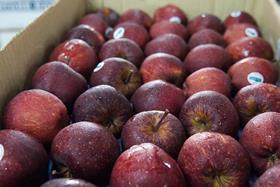
India’s burgeoning apple import business, which more than doubled in size between 2006/07 and 2009/10 to reach almost 100,000 tonnes, is facing a major cost crunch this season.
Sales movement of apples and other imported fruits has slowed dramatically in the past few weeks as consumer prices soar by rates of up to 25-35 per cent, according to local importers.
The recent depreciation of the Indian rupee against the US dollar is the major culprit for the price hike, especially given that close to half of India’s apple imports traditionally come from Washington State.
“Our currency has depreciated by almost 20 per cent against the US dollar in the last four or five months,” said Gagan Khosla of importer NGK Trading. “Then there is a 50 per cent duty on apple imports, so effectively our costs have gone up by 30 per cent.
“Add to that the fact that the FOB price of Washington `Red Delicious` apples is around 10 per cent higher than last year, and the net effect is a 35 per cent price hike in the market. Acceptance of product `from consumers` at these prices is non-existent. Sales have slowed to a trickle and fruit is backing up `in storage`.”
The Indian rupee plunged to a record low against the US dollar of Rs54.305 on 14 December, and while it has recovered some ground in the past week to reach 52.49 yesterday (21 December), the outlook for the currency remains bearish.
“The current market for Washington apples is very gloomy,” said Sanjay Shah of Adani Agrifresh, which is a major player in domestic apples as well as importing from the US and other sources. “Importers are loosing heavily on account of the high sourcing price and the exchange rate.”
Many importers have sought to mitigate the impact of the exchange rate by currency hedging, but losses appear unavoidable. “A lot of importers will lose big money and there’ll be a lot of defaulting on payments,” predicted Ambrish Karvat of importer Yupaa International.
Chinese apple costs even higher
As well as the increase in sourcing costs from the US, importers are facing a steeper climb in prices from China, which is the other major apple import source with the Fuji variety in particular.
“China might have more fruit available this year, but the costs are 12-15 per cent higher than last year’s rates, which were already high – this market is not willing to pay that kind of premium,” said Khosla. “Higher grade Chinese Fuji is costing almost US$30 per carton landed, which is a bit more than Washington `Reds`. Nobody will pay that for Chinese Fuji, because no matter what you do, you’ll always have some bad or mixed fruit in the box.”
No domestic shortage
Shipments of Washington apples to India got off to a brisk start this year amid reports of a significant shortfall in production of domestic apples, particularly in Himachal Pradesh. Those reports served to push up domestic apple prices early in the season. “Growers have been getting big prices because all of the fruit was bought up for storage and now the cold rooms are heavily stocked,” said Karvat. “I’d estimate that 75 per cent of the Himachal Pradesh fruit is still in cold rooms. They’ve only sold 25 per cent because prices are too high.'
Meanwhile, Jammu & Kashmir, which accounts for a larger percentage of domestic production than Himachal Pradesh, has experienced a good-sized crop but quality is below par, according to industry sources. “There’s plenty of fruit from Kashmir but it was harvested overripe so it doesn’t have the shelf life,” said Karvat. “It won’t keep in cold rooms, so now it’s spoiling and selling at whatever prices the vendors can get.”
Shah predicted that the large supplies of poor-to-average quality Kashmir fruit would continue until mid-January. Indeed, he and other industry sources forecast the tough conditions for imported apples to prevail for a while yet.
“This `tough market` will continue until at least March,” predicted Karvat. “Many Indian fruits have got really good crops. Pomegranates, grapes, papayas and watermelons are all profusely available at low prices.”
Bumper volumes of Indian kinnow oranges from Rajasthan and Punjab are currently pouring into the wholesale markets with good quality and low prices, according to Shah, which is affecting demand for fruit imports.
Alternative sources
Faced with the high cost of Washington Red Delicious and Chinese Fuji apples, some importers are exploring cheaper supply sources.
French and Italian apple exporters have begun to get a look-in with Red Delicious and other red-coloured varieties, aided by the more favourable exchange rate between the euro and the Indian rupee.
“We’re bringing in more French and Italian apples,” said Vinit Nagdev of Mumbai-based importer Pappu international. “They’re not as good as the Washington apples in terms of shelf life but the French Red Delicious are sweeter and cheaper. We’re paying around US$24-25 per 20kg carton `count 100-138` for the French Red Delicious, compared with U$31-33 per carton for Washington fruit (count 125`.”
Lalit Vasandani of BFC Enterprises, who has begun importing French apples under the Coopex brand, is also pleased with the outturns. “French apples are new to the market, and the pressures, quality, shelf life and colour are all good,” he said of shipments of French Red Delicious.
While Pappu International only began importing Italian apples last year, Nagev said their success depended on being cheaper than Washington Reds given the inferior standards. “Their Red Delicious are more striped that Washington,” he said. “The quality is good enough but this variety is only a very small percentage of Italian production and their Red Starking doesn’t have the shelf life.”
In addition to ordering European apples, importers have been taking more Chinese Red Delicious – known as Huaniu apples – to supply the lower end of the market. “These apples only cost around US$20 per 20kg box and while the quality is poor, you can make money on them,” said Vasandani.



